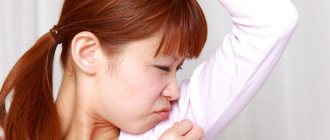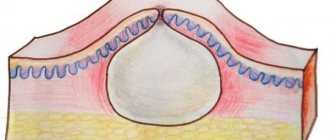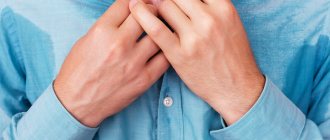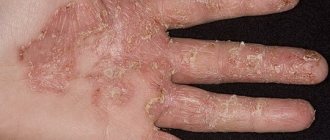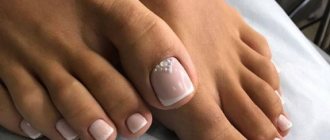Hyperhidrosis of the feet is a pathological condition, the characteristic feature of which is constant profuse sweating against the background of a pungent and rather unpleasant odor. In some cases, a complication in the form of infection is possible. People suffering from this disease often have serious psychological problems - they feel awkward and very constrained due to the constant fear of being in an awkward situation at a party, in the gym or in a shoe store. Excessive sweating of the feet can be caused by both external factors, which mainly depend on the person, and internal diseases.
What is foot hyperhidrosis
The human body produces sweat, which is 99% water. The main purpose of this liquid is to cool the body during physical activity, as well as during overheating during heat. Sweat glands actively work in the sun. In addition, a person may sweat profusely during times of stress or anxiety. Most sweat glands are located in the armpits, palms and soles.
Hyperhidrosis is a pathological condition associated with excessive sweating. In this case, the sweat glands secrete a lot of fluid in one or more areas of the body. In addition to excessive moisture in the armpits, palms, or feet, the problem is also associated with an unpleasant odor. All this affects a person’s self-esteem, and ultimately can lead to disruption of the central nervous system.
Reviews
Reviews about eliminating sweating feet are of a different nature, since many successfully combat the problem with the help of improvised means, and some never received the expected result.
My feet constantly sweat, so I use cream under my socks, and in hot weather I try to open my feet as much as possible to ensure natural ventilation. Even with severe sweating, it can be completely eliminated.
Andrey, Volgograd
Even though I’m a girl, my feet sweat a lot, and lately I’ve been doing baths with pine needles, and the result is clearly visible. At the same time, during the heat, the foot does not slip and does not fall out of the shoe.
Marina, Moscow
Types of hyperhidrosis
- Local – there is increased sweating in certain areas of the body.
- Generalized – the skin of the whole body sweats.
- Seasonal hyperhidrosis is characteristic of the warm period, which is associated with changes in ambient temperature.
- Constant – increased sweating is present at any time of the year.
- Primary hyperhidrosis occurs in adolescents during puberty.
- Secondary is the result of a disease or treatment with certain medications.
How it manifests itself
Excessive sweating cannot be defined in terms of “amount of sweat.” But if excessive sweating interferes with daily life and normal activities, we can talk about hyperhidrosis.
The essence of foot sweating is increased secretion of sweat in the leg area. The condition is aggravated even with slight physical stress or mild anxiety.
Typical signs for pathology, sometimes identified independently of each other:
- Sweating in the feet, despite wearing high-quality shoes.
- Sweating even at rest, in the absence of excitement or physical activity.
- The amount of sweat causes discomfort.
The next sign of the disease is the difficulty of getting rid of increased secretion of sweat using hygiene products.
The pathology is also manifested by psychological signs: irritability, nervousness, sudden changes in mood.
The presence of foot hyperhidrosis can be determined independently using the following test. If you answered yes to any of the questions below, you are most likely suffering from a nasty disease.
- Do your feet sweat immediately after waking up or at the mere thought of sweating?
- Are your feet not only sweaty, but also cold?
- Is sweating constantly present, even if the ambient temperature is low, and there is no obvious cause of the problem?
- Does sweat soak into your shoes and leave white marks on them?
- Is the skin on your feet irritated and damaged due to constant sweating?
- Is it difficult to walk in flip-flops in the summer because your feet slip when walking?
What causes the development of foot hyperhidrosis?
This pathology causes a lot of inconvenience in a person, which affects the psycho-emotional state. Hyperhidrosis of the feet indicates the appearance of a large amount of sweat, as well as an unpleasant odor. As a result, a person becomes ashamed to take off his shoes when visiting. When moving, the disease also causes some discomfort. If foot hyperhidrosis is not treated and clinical recommendations are not followed, all this will provoke strong feelings that will ultimately result in low self-esteem and isolation.
Recommended articles on the topic:
- How to massage the abdomen for weight loss: different techniques for health and beauty
- Stone massage: description, benefits, methods
- MRI of three parts of the spine: when is it necessary and what are the features of the procedure
Some people are too embarrassed about their problem and do not seek help from a doctor. Such patients often look for solutions in traditional medicine, where there are many recommendations and recipes in this regard. However, without an accurate diagnosis and identification of the underlying cause, treatment of foot hyperhidrosis is impossible. Therefore, if characteristic symptoms appear, it is necessary to consult a specialist and undergo an examination.
The main causes of foot hyperhidrosis include:
- incorrectly selected shoes;
- failure to comply with personal hygiene rules;
- wearing shoes that do not fit (tight), as well as those made from low-quality artificial materials;
- the presence of benign or malignant tumors in the body;
- disruption of the central nervous system;
- hormonal imbalances;
- overweight and obesity;
- diabetes;
- pathologies of the thyroid gland;
- problems with the cardiovascular system;
- hypertension;
- bad heredity;
- VSD (vegetative-vascular dystonia).
Causes of increased sweating of feet in adults and children
Increased sweating of the feet is accompanied by significant discomfort and the appearance of an unpleasant odor, especially in the summer.
Hyperhidrosis in adults can occur for a number of specific reasons:
- Heart diseases, which are accompanied by high blood pressure, since the acceleration of blood supply contributes to the active production of sweat glands, which is marked by the appearance of profuse sweating;
- Colds. During an acute inflammatory process, the number of leukocytes in the blood increases, which contributes to an increase in temperature and the appearance of increased sweating;
- Respiratory diseases (tuberculosis, bronchitis). Heavy sweating is explained by increased formation of spasms due to severe coughing. Hyperhidrosis develops with a lack of oxygen, since in this case metabolic processes aimed at restoring the body are accelerated;
- The development of hypothyroidism (lack of hormones due to disruption of the thyroid gland). This condition is characterized by sudden bursts of cold sweat and a sharp increase in body temperature;
- Excess body weight, acute diabetes mellitus. Diseases of this nature often occur with a sedentary lifestyle and cause constant “wet feet” syndrome;
- Oncological processes in the body. Malignant tumors in the body require a large amount of energy, due to which constant profuse sweating is formed;
- Diseases of hormonal origin. In men, profuse sweating occurs during andropause; women suffer from hyperhidrosis of the feet during pregnancy, with hyperthyroidism;
- Lack of proper personal hygiene of the legs and feet, since an abundant amount of dirt on the skin creates favorable conditions for the proliferation of pathogenic microorganisms and the occurrence of various dermatological diseases;
- Constant physical activity increases the load on the legs, which contributes to the formation of profuse sweating and the possible addition of a bacterial infection with the appearance of an unpleasant odor and splitting of the nails;
- Incorrectly chosen shoes that are too tight or a little too big. Wearing Chinese shoes made of leatherette ensures profuse sweating, so the feet do not breathe, and at the same time pathogenic microorganisms develop on the skin;
- Wearing warm socks and boots. If in the summer there is one pair of closed shoes, then increased sweating occurs when the temperature changes. Therefore, it is necessary to select appropriate fabric from natural materials.
In children, the causes of increased hyperhidrosis arise from the following provoking factors:
- Infection with parasites, as the development of roundworms in the body contributes to profuse sweating. If suspicious symptoms appear in the form of a dry cough, itching in the anal area, it is necessary to undergo certain tests (stool examination);
- Lack of vitamin D in the body, which is produced when exposed to direct sunlight. This symptomatology indicates the initial stage of rickets and requires the use of special therapeutic measures;
- Serious disorders of the central nervous system (mental illnesses, dysfunction of the musculoskeletal system, development of hypertension, hypotension).
Symptoms of foot hyperhidrosis
The main sign of foot hyperhidrosis is increased sweating in the lower legs for no apparent reason. There may be no specific symptoms, but the skin becomes moist even at rest. This happens regardless of the ambient temperature. When you wear socks or tights on your feet, they quickly get wet. This also applies to shoes.
The second obvious sign of hyperhidrosis is an unpleasant odor. It does not go away even with regular foot washing. The use of special deodorants and scented pads allows you to get rid of it only temporarily.
We recommend
Anti-wrinkle facial massage: 10 effective techniques Read more
Hyperhidrosis is often accompanied by a fungal infection. When humidity is high in shoes, a “greenhouse effect” occurs, which provokes increased growth of mycotic microorganisms. It is very difficult to cure fungus in the presence of hyperhidrosis. Most often, therapeutic measures provide only temporary results. The presence of a fungal infection can be determined by constant itching and burning in the area of the foot and between the toes. The affected skin becomes red and begins to peel off severely.
You can find out that the cause of foot hyperhidrosis is a psychogenic factor by the following symptoms:
- My feet suddenly started to sweat a lot, but this is not due to age-related changes.
- Recently, a person experienced serious psychological trauma.
- At night, foot sweating decreases.
- The disease is recurrent, so it can worsen with strong emotional disturbance.
- Increased sweating is observed not only on the feet, but also in the armpits, as well as on the palms.
If the cause of the problem lies in a malfunction of the vegetative-vascular system, the symptoms will be as follows:
- Cold and damp extremities.
- Paleness of the skin.
- Restless sleep.
- Poor tolerance to bright light, heat and drinks with high caffeine content.
- Often there is a feeling of chilliness and tremors of the limbs.
The presence of idiopathic, that is, primary hyperhidrosis, is indicated by the following signs:
- The manifestation of the disease occurred at an early age, that is, in childhood or adolescence.
- Presence of a similar diagnosis in a blood relative (optional).
- Sweating does not increase with excitement.
- Hyperhidrosis is mainly observed in the armpits, palms and feet.
- Hyperhidrosis does not bother me at night.
- There are no other symptoms.
- In the presence of endocrine hyperthyroidism, an increase in sweating is observed in the evening and at night. Under nervous stress and stress, the sweat glands work normally.
Sweating caused by poor personal hygiene should not be confused with true hyperhidrosis. Sweating is a normal process that necessarily occurs in the human body. Without it, thermoregulation will be impaired, which will lead to overheating under the influence of elevated ambient temperatures, excitement and other factors.
For this reason, you should not worry if your feet begin to sweat due to:
- Long-term wearing of shoes.
- Violations of personal foot hygiene rules.
- Wearing clothes and shoes made from low quality materials.
- Violations of body thermoregulation, which often occurs during prolonged presence in a room with a high temperature, during active physical activity, etc.
- Wearing shoes of the wrong size.
Similar reasons can cause increased sweating. But once they are eliminated, the symptoms of hyperhidrosis will immediately disappear. In this case, no specific treatment is needed.
Pathological causes include the following:
- Psychogenic. In this case, the symptoms intensify during stressful situations and emotional shocks. When the provoking factor is eliminated, hyperhidrosis does not disappear, but subsides. With new emotional disturbances, unpleasant symptoms return. Increased sweat production is possible due to neurosis, asthenia, insomnia, etc.
- With idiopathic hyperhidrosis, there is increased sweating of the armpits, palms and feet. The disease is characterized by excitability of the sympathetic nervous system. Heredity plays a big role here, since pathology often occurs in blood relatives. The problem can be noticed in patients in childhood. During puberty, hyperhidrosis becomes most noticeable. With age, the severity of symptoms decreases.
- Endocrine causes are associated with the pathological functioning of the endocrine glands. Hyperhidrosis can be a consequence of diseases such as diabetes, hyperthyroidism, obesity, etc. When the functioning of the endocrine glands is impaired, not only the feet, but also other parts of the body, including the palms, armpits, face and back, sweat intensely.
In some cases, hyperhidrosis becomes one of the symptoms of oncology and infectious processes occurring in the body. Sometimes the feet begin to sweat a lot from a common cold, but it happens that the cause of the pathology is syphilis, tuberculosis, hepatitis and HIV.
Treatment of excessive sweating in children
The phenomenon of hyperhidrosis in children under 5 years of age does not pose a danger, since during this period the thermoregulation system is adjusted and gradually completely normalized. The main ways to eliminate excessive sweating:
- Mandatory intake of medications containing vitamin D for the treatment and prevention of rickets. In this case, Aquadetrin drops are effective;
- Undergoing a preventive examination by a neurologist and pediatrician. To eliminate this, a course of special massage is recommended;
- Pyramidal insufficiency or ICP involves undergoing a course of treatment with special drugs to improve brain function. Eliminating neurological problems allows you to get rid of excessive sweating.
In most cases, the cause of increased sweating in a child is exposure to provoking environmental factors (warm clothing, high room temperature, dry air).
Diagnosis of foot hyperhidrosis
To determine the cause of foot hyperhidrosis, it is necessary to undergo a comprehensive examination using instrumental and laboratory techniques. This disease is treated by dermatologists. After special tests, the presence of pathology can be determined, as well as the severity of the disease and its cause.
The main diagnostic methods include:
- Minor's sample. Here starch is used, which is applied to the skin after lubricating it with iodine. Normally there should be no staining, but with hyperhidrosis an intense purple tint is noted. A clear color boundary allows for differential diagnosis of a local disease with other ailments in which excessive sweating is observed.
- Gravimetric test. This method determines the amount of sweat that comes out of the skin in one unit of time. Here, filter paper is used, which is weighed before and after application to the skin on the feet. In this way, the severity of the pathology can be determined.
- If a patient suspects a foot deformity, a consultation with an orthopedist and photoplantography using computer equipment will be a prerequisite. In cases where the probable cause of excessive sweating is problems of the central nervous system, a consultation with a neurologist is prescribed. Psycho-emotional disorders require attention from a psychotherapist. If diseases that can cause excessive sweating of the feet are excluded, a diagnosis of “essential hyperhidrosis” will most likely be made.
Diagnostics
Diagnosing foot hyperhidrosis is not difficult. It is much more difficult to determine the reason why this thermoregulation disorder occurs. A visit to the doctor's office begins with interviewing the patient. The doctor must find out how long the person has been bothered by this problem, and whether any other family members suffer from hyperhidrosis. To identify the cause of hyperhidrosis, the following tests are required:
- Donating blood for general and biochemical analysis.
- Donating blood for thyroid hormones.
- Donating blood for hepatitis, HIV, hidden sexually transmitted infections.
- Donating blood to determine blood glucose levels.
- Submission of urine for general analysis.
Based on the results of these studies, it will be possible to guess the nature of hyperhidrosis and prescribe quality treatment to the person. It is possible that consultation with specialized specialists (endocrinologist, neurologist, psychotherapist, etc.) will be required.
If all indicators are within normal limits, this indicates the idiopathic nature of foot hyperhidrosis.
Treatment of foot hyperhidrosis
Treatment of hyperhidrosis without identifying the cause is impossible. A consultation with a specialist is necessary who will make a diagnosis and prescribe the necessary procedures. Only after this can you begin to fight unpleasant symptoms.
If you cannot completely get rid of the cause of excessive sweating or the disease is hereditary, you should use special means, which include:
1. Deodorants and antiperspirants.
These drugs are considered the most affordable and easiest to use. But deodorants can only mask the smell. They do not affect the amount of sweat. Antiperspirants reduce the intensity of fluid secretion. Since the products have multidirectional effects, they can be easily used simultaneously.
However, they must be applied to dry and clean skin. It is best to use medications before bedtime. Modern antiperspirants can relieve sweaty feet for a period of two to ten days, depending on the intensity. Medicines for foot hyperhidrosis are available in sprays, roll-ons, applicators and powders.
Odaban is a spray antiperspirant that is suitable for all skin areas. Effectiveness after one application lasts for ten days. You can use the product for an unlimited time.
Dry Dry is considered one of the most popular among people suffering from foot hyperhidrosis. It should be applied three times a week.
Maxim Dabomatic 30% is a product with a convenient applicator. The composition can be used on any part of the body. The drug is very economical, so one bottle lasts for a year.
When using antiperspirants and deodorants, allergic dermatitis may occur, which disappears either after their discontinuation or with the parallel use of antihistamines.
Among the safest ways to get rid of excessive sweating of the feet, it is worth highlighting baby powder, starch and talc. But these products have only a short-term drying effect.
We recommend
How to get rid of blackheads: the most effective ways Read more
2. Creams, gels with deodorant and antiperspirant properties.
One of the modern forms of antiperspirants is cream and gel. Their action is no different from the usual rollers and sticks. The main difference lies in the method of applying the drug.
The cream and gel are evenly distributed over the cleansed skin of the feet. After the composition is completely absorbed, you can put on socks or shoes.
Similar remedies for foot hyperhidrosis include Step balm, produced by. It contains fir oil, which regulates the functions of the sweat glands. In addition, the strong pine aroma has a deodorizing effect.
The popular brand Rexona also did not stand aside and released the product “Deo-control”. It not only controls sweat, but also fights harmful bacteria that cause odor.
3. Deodorant gels.
Here the principle of operation is similar to the previous options. The products mask the odor and also reduce sweat production. The gel base is easy to spread over the surface of the skin of the foot.
Rexona foot deodorant not only reduces sweat production, but also improves skin condition by moisturizing and nourishing.
The Malava company produces a gel-type product with citrus extract. It eliminates odor and destroys bacteria on the skin of the feet.
Among domestic manufacturers we can highlight. The products from this company are natural and effective. The range also includes foot gel with eucalyptus and oak bark.
4. Antiperspirant creams.
Faberlic cream antiperspirant contains talc and menthol. Feet after using the product become fresh and dry.
The Russian remedy works similarly. In addition to deodorizing, it eliminates bacteria that cause unpleasant odors.
Aller cream antiperspirant normalizes the functioning of the sweat glands and also reduces the risk of fungal infections.
5. Medicines.
In this category, Urotropin is considered one of the best. This is an antiseptic drug that can be purchased in the form of liquid in ampoules or in powder. The product is applied to clean skin of the feet under cotton socks. The course of treatment is two to three weeks.
Borozin powder is very convenient to use, as it can be poured into shoes. The drug reduces sweat production and removes unpleasant odor. In Latvia, the product is used in the army to prevent fungal diseases in extreme conditions.
Teymurov's paste shows high efficiency. One application allows you to forget about the problem of hyperhidrosis for a week. You need to lubricate the skin with a thick layer and wait for the time specified in the instructions. A similar effect in getting rid of hyperhidrosis of the feet is produced by zinc-based ointment, which controls the process of sweat secretion.
6. Iontophoresis.
The essence of this procedure is to constantly expose the problem area to a small discharge of electric current. Due to this, the medications used penetrate deeper into the patient’s body and provide high efficiency. The skin remains intact. Iontophoresis is also carried out without the use of medicinal compounds. In this case, ordinary water and current are used.
As a rule, the procedure is performed in specialized medical institutions. Iontophoresis is done every day or every other day. The course consists of 20–25 sessions. After this, the patient comes for iontophoresis once a month to maintain the result.
The procedure is very effective. After it, the patient can forget about the problem of excessive sweating for a long time. The Ionto-mini device is suitable for home use. This is an iontophoresis device that does not require special knowledge. Treatment of foot hyperhidrosis at home is not only more convenient, but also economical.
7. Surgical treatment of hyperhidrosis.
This method of getting rid of the problem is called sympectomy. The cost of the operation is quite high, and there are many side effects, so the method is used in extreme cases. But it is precisely this technology that can eliminate the problem of hyperhidrosis forever. During the operation, the sweat glands in the problem area are removed, and the nerves responsible for transmitting impulses are blocked/ligated. Some glands are destroyed by electric current.
The use of surgical methods is justified only if other methods do not help. When cosmetology and conservative treatment prove futile, surgery can be tried. Also, this option for eliminating the problem of hyperhidrosis is suitable for situations where the pathology is caused by diseases of the thyroid gland and cardiovascular system.
After surgery, the rehabilitation period lasts from two to seven days. This is followed by a month and a half of recovery regime.
We recommend
Therapeutic massage for the back: features, indications and contraindications More details
8. Botox injections.
This is a highly effective procedure, but expensive and quite painful. After Botox, you can forget about foot hyperhidrosis for up to ten months. This happens because the injected drug blocks the nerve endings that send signals to the sweat glands. As a result, fluid production stops. Most often, a second course of injections is prescribed after six to eight months. The procedure is carried out in an equipped cosmetology room. Within one to three days you can notice a positive result.
The decision regarding the need for Botox injections containing botulinum toxin for foot hyperhidrosis must be made by the patient and a qualified specialist. Regardless of the level of discomfort the disease causes, this method will allow you to quickly cope with the problem. But first you need to find out the cause of the pathology, because excessive sweating can be caused by tuberculosis, diabetes and even cancer.
If the procedure is performed by an experienced specialist, the injections will take from 40 minutes to one hour.
But first, the patient needs to do a Minor test. This will allow you to determine the intensity of sweat secretion, as well as calculate the required amount of the drug. Then the problem area is disinfected. The alcohol composition must dry completely and be absorbed. Otherwise, the Botox may degrade. Modern clinics often use alcohol-free disinfectants.
After preparatory treatment, marks are placed on the problem area every 2 cm using a marker or brilliant green. The drug will be injected into these places.
The needle pierces the skin no more than 3 mm. However, the procedure creates significant discomfort. Patients often complain of a burning sensation, which is considered normal.
A cooling compress is applied to the treated area. Then final disinfection is carried out.
How to deal with sweating
Since hyperhidrosis of the palms is most often idiopathic in nature, to eliminate the pathology at the initial stage of treatment the following is used:
- Antiperspirants that are applied to the problem area. The effectiveness of these remedies for hyperhidrosis depends on the amount of aluminum contained and the correct use of antiperspirants.
- Formagel is an effective remedy for sweaty hands, which contains formaldehyde, which has a tanning effect.
- Teymurov's paste is a multi-component antiseptic, the use of which requires consultation with a doctor, as it can cause side effects with prolonged use.
You can also turn to folk remedies. You can read how to get rid of sweaty palms using herbal decoctions here.
Traditional medicine recipes for sweaty feet
There are also traditional methods to combat excessive sweating of the feet. They reduce sweat production and also effectively eliminate unpleasant odors.
- In the fight against hyperhidrosis of the feet, sage is considered one of the best natural medicines. Take two cups of boiling water for a teaspoon of crushed leaf. After preparing the infusion, the liquid is filtered through cheesecloth. You need to take two tablespoons twice a day for two weeks.
- An acidic solution made from lemon zest and juice, as well as apple cider vinegar, helps with excessive sweating of the feet. If the last component is not available on the household, you can use ordinary table vinegar, but it is first diluted with water in a ratio of 1:5. Acid foot rubs allow you to forget about the unpleasant odor.
- Problem areas can also be treated with 20% aluminum chloride. It is applied not only to the feet, but also to the skin between the toes.
- At night, you can pour a teaspoon of crushed oak bark into your socks. You can also add a little sage, chamomile flowers and mint leaves.
- When performing hygiene procedures before going to bed and after getting up, it is advisable to use soap with an antibacterial effect.
- If an unbearable smell of sweaty feet appears, you should rinse your feet with a weak solution of potassium permanganate.
- Lavender oil can be used to treat hyperhidrosis. It is diluted 50% with coconut or olive oil. Before going to bed, rub the product into the skin and put socks on your feet.
- For excessive sweating of the extremities, experts recommend taking baths with sea water. Solar heating helps, during which Teymurov's paste is used.
- The release of large amounts of sweat can be eliminated by methenamine powder. It can also be used for preventive purposes once a week.
- Birch leaves, which are squeezed between the toes several times a day, are considered a good folk remedy.
- The soles can be treated with glycerin-based ointment, and then moistened with a solution of 5% iodine and water. Then you need to put socks on your limbs.
- Steaming your feet with bay leaf infusion helps a lot. It is prepared from three liters of hot liquid and several dry sheets. Everything is infused for half an hour. Feet should be steamed 20 minutes before bedtime.
- In the morning, it is useful to rinse your limbs with cool salt water. For one 200 ml cup you need to take a teaspoon of sea salt.
- You can combat unpleasant odor with tea leaves that are placed in your socks in the morning.
- You should take an infusion of sage internally. It is made from a glass of hot water and a teaspoon of herbs. After half an hour, the product must be filtered and taken a tablespoon twice a day for 20 days.
- Within a month, you can get rid of excessive sweating of the feet using boric acid powder. It is rubbed into the sole and between the toes, and then socks are put on.
- Traditional medicine specialists advise using crushed oat and barley straw along with wheatgrass. These components should be poured into socks that are worn before bed. In the morning, your feet should be rinsed with sage decoction. The treatment course lasts three weeks.
Homemade foot baths are often recommended for people who suffer from foot hyperhidrosis. There are many effective recipes for their preparation:
- Boil oak bark in one liter of water for 30 minutes. The liquid is used to prepare a bath in which the feet should be kept for about half an hour. You cannot use the same decoction twice. This is an effective remedy, but with prolonged use of oak bark, dark spots appear on the legs.
- You can rinse your limbs with a warm salt solution. Take a teaspoon for one glass. The procedure must be repeated two to three times a day. After rinsing, feet should be rinsed in running water.
- Twenty bay leaves are poured into three liters of boiling water. Everything is infused for 30 minutes. The bath should be done 20 minutes before bedtime.
- A medicinal liquid can be prepared from dried sage, nettle and mint leaves, taken one tablespoon at a time. The herbs need to be thrown into boiling water and left for 40 minutes. Wellness baths are done every day for 20 minutes.
- One of the simplest recipes is to use lemon peels to get rid of sweaty feet.
Features of the treatment of sweating feet
Treatment tactics depend on the reasons that provoked hyperhidrosis. For thyroid problems and diabetes, baths, creams and ointments will eliminate sweating for a short time.
Treatment of leg hyperhidrosis in women
First, find out if you really have a problem.
To do this, perform a simple test. Wash your feet in warm water and soap and dry them. After this, apply the iodine solution to the foot and let it dry. Sprinkle your feet with starch. If your feet turn blue, then you actually have foot hyperhidrosis. Non-medical treatments for sweaty feet:
- Wash your lower extremities with soap in the morning and evening. It is advisable to gradually reduce the water temperature. So, you will affect thermoregulation.
- Use antibacterial soap. It is best if you purchase regular household items.
- After water procedures, dry your feet and sit for another 15 minutes without socks. It is necessary that the limbs are completely dry. After this, you can lubricate your feet with anti-odor cream.
- To treat sweating in women, which is caused by diseases of the internal organs, it is necessary to get rid of the cause. Otherwise, your feet will still sweat. During menopause, it is recommended to take hormonal medications. By reducing the frequency of hot flashes, sweating of the feet and the whole body will decrease.
Treatment of sweaty feet in men
Of course, you should initially make sure that sweating is not caused by some serious illness.
To do this, contact your therapist, he will prescribe all the necessary tests. If hyperhidrosis is a consequence of a serious illness, then it will disappear during the treatment of the disease. Rules for eliminating sweaty feet in men:
- Change your socks often. If you cannot wash your feet during the day, carry wet wipes with an antibacterial effect.
- Don't wear rubber shoes.
- Choose boots according to the weather.
- In the summer, wear flip-flops or flip-flops if possible. Choose shoes made of genuine leather or suede.
- If you detect an unpleasant odor, wipe the inside of the boots with a solution of vinegar or turpentine.
- Throw away the old insole and get a new one made of leather.
- It is useful to take a solution of calcium gluconate. It is the lack of this mineral that can cause sweating. For treatment, drink 20 g of a 10% solution three times a day.
- You can lubricate your feet with a mixture of talc and starch. These substances absorb sweat, making your feet dry.
Treatment of hyperhidrosis of the legs in a child
If a baby's feet sweat before 1 year of age, this is not a cause for concern.
The baby does not have a well-established thermoregulation system; the body itself does not quite correctly understand when to cool the body. Methods for treating “wet feet” in children:
- In winter, give children under 2 years of age 1-2 drops of Aquadetrim. This is vitamin D, which is used to treat and prevent rickets in children, which causes sweating.
- Get preventive examinations from a pediatrician and neurologist. If sweating feet is caused by decreased muscle tone, it is enough to undergo several courses of stimulating massage to eliminate the problem.
- For ICP and pyramidal insufficiency, it is worthwhile to undergo a course of treatment with drugs that improve brain function. By eliminating neurology, you will get rid of sweating.
Remember! In most cases, the cause of sweating feet in babies is the mother’s excessive care. Many women dress their child “like cabbage.” Due to active movements, feet in warm boots sweat. In addition to the unpleasant odor, wet feet can cause a cold.
Gymnastics for foot hyperhidrosis
At home, you can fight hyperhidrosis with gymnastic exercises. They improve blood circulation in the problem area, which normalizes the functioning of the sweat glands.
Exercises are performed ten times each:
- Walking barefoot on the toes, inner and outer parts of the foot.
- Circular movements of the foot counterclockwise and clockwise.
- Rolling a ball with your toes while sitting.
- Grasping objects, such as a ballpoint pen or pencil, with your toes.
- Squats on one leg - alternately on the right and left.
These gymnastic exercises will take no more than ten minutes a day, but will give a good therapeutic effect.
Treatment
If symptoms of the disease appear, you must consult a doctor who conducts a survey, prescribes appropriate tests, and takes photographs if necessary.
You can reduce sweat production using special products that affect the functioning of the sweat glands. These include long-acting deodorants, such as Dry Dry, Maxim, DEO control.
They clog the sweat glands, help reduce sweating, and prevent unpleasant odors from spreading. But before using such remedies, you should consult your doctor.
Prognosis and prevention
Hyperhidrosis is incurable, but not dangerous. However, it affects the quality of life, so complex therapy cannot be avoided. Effective methods make it possible to get rid of unpleasant symptoms for a long time. In extreme cases, surgery is used, but this requires strong evidence.
Prevention of hyperhidrosis is as follows:
- Using socks and tights made from natural fabrics that absorb moisture well and allow air to pass through.
- Shoes should be made of breathable materials. In summer you should not wear closed shoes.
- Twice a day you need to wash your feet with warm water. Contrast baths will help with excessive sweating.
- Flat feet are a common cause of hyperhidrosis. Healthy feet sweat less often.
- Antibacterial herbal products not only eliminate sweat, but also kill odor-causing bacteria.
- Any diseases must be treated on time and until complete recovery, before they lead to chronic hyperhidrosis.
Calmness and the absence of nervous tension are the key to healthy legs without excessive sweating.
Nowadays, you no longer have to spend a lot of time performing complex and unpleasant procedures at home. It is much easier to seek help from real professionals - the Veronika Herba beauty and health center, equipped with effective and modern equipment.
Why clients choose Veronika Herba Beauty and Health Center:
- This is a beauty center where you can undergo treatment for foot hyperhidrosis at a reasonable cost, and you will be treated by one of the best specialists in Moscow. This is a completely different, higher level of service!
- You can receive qualified help at any time convenient for you. The beauty center is open from 9:00 to 21:00, seven days a week. The main thing is to agree with your doctor in advance on the date and time of your appointment.
Sign up for a consultation with a specialist by phone 8 (495) 995-15-13
, and you will see for yourself!
Prevention
Prevention of increased hyperhidrosis of the legs is based on following the recommendations below:
- Maintaining daily hygiene of extremities;
- Using separate towels for each family member;
- The use of wet wipes when there is no possibility of washing feet;
- Avoid wearing other people's socks and shoes;
- Selection of high-quality shoes and socks made from natural materials (leather, cotton, linen);
- Use of special absorbent insoles and antibacterial deodorants for shoes;
- Having a change of shoes when working in production or in the office.
Tips and tricks
- Getting rid of foot odor can be quite easy, you just need to wash your feet regularly. In some cases, the use of antibacterial soap is recommended. However, certified dermatologists and cosmetologists believe that using this product 2-3 times a day will be sufficient. The reason is that the microflora and the protective layer of the dermis may be disrupted. Subsequently, such a hygienic procedure may result in fungal foot pathologies.
- Carefully scrape the areas between the fingers, as this is where the greatest amount of sebum, dead skin and dirt is concentrated.
- The best method to achieve impeccable cleanliness is the following: after washing and drying your feet, press cotton swabs soaked in apple cider vinegar between your toes for 5 minutes. However, if vinegar causes irritation or inflammation, then it is better not to practice this technique.
- Of course, do not forget to trim your nails and remove the skin that forms at the base of the foot. The point is that it is in these places that pathogenic microflora can form.
If it is not possible to buy pharmaceutical drugs, use the means at hand. Soda, talc, corn starch in a ratio of 0.5:1:1. After mixing thoroughly, two grams of salicylic acid are added to the mixture. Eco-friendly powder is ready for use. You can powder your feet with it after washing.
Was the article helpful?
Rate the material on a five-point scale!
( 2 ratings, average: 4.50 out of 5) If you have any questions or want to share your opinion or experience, write a comment below.
Signs of pathology
Sweat contains water, ammonia, salts, and also contains lactic, citric and ascorbic acids.
Sweating normally increases in hot weather or when a person is in a stuffy, unventilated place.
Hyperhidrosis can be primary or secondary. In the first case, the cause of the disease is the activity of nerve endings and, as a consequence of their work, increased sweating. Secondary hyperhidrosis is a symptom of a chronic disease, when eliminated the problem disappears.
Hyperhidrosis is identified by the main symptoms:
- when wearing good shoes for the season, your feet continue to sweat;
- sweating is present even when you are at physical and emotional rest;
- ineffectiveness of deodorants and powders.
The appearance of an unpleasant and pungent odor indicates the addition of bacteria or fungal infection to the disease.
Associated symptoms
Excessive sweating can be alarming in the presence of accompanying symptoms, such as loss of appetite and sudden weight loss, prolonged cough, prolonged increase in body temperature, enlarged lymph nodes, increased heart rate, painful cramps in the abdomen, and abnormal blood pressure. In these cases, it is recommended to consult a doctor.
In some cases, along with excessive sweating, an unpleasant odor may be bothersome. This is due to the fact that sweat contains certain organic substances, which, when released onto the surface of the skin, begin to decompose the bacteria located there. These bacteria, when decomposed, release fatty acids, which are the cause of unpleasant foot odor.
Exactly how a person smells when they sweat excessively depends on the type of bacteria that predominates on the person’s skin and the organic substances that they decompose:
- when fatty acids decompose, the smell is sour, vinegary;
- when proteins and amino acids decompose, a rotten smell, the aroma of cheese, appears;
- when androstenone decomposes, the smell of urine and ammonia appears;
- When androstenol decomposes, a musky odor is felt.
Excessive sweating creates favorable conditions for the development of fungal infections. Therefore, foot fungus is often combined with increased sweating and the presence of unpleasant foot odor.
Causes of excessive sweating
The problem of high humidity in the feet is dealt with by specialists - dermatologists.
The culprits of sweating and hyperhidrosis of the feet are:
- heredity (often when collecting a history of a disease for treatment, doctors find out that the patient’s relatives also suffered from this disease);
- cardiovascular diseases and disruptions in blood supply;
- infectious pathologies that are accompanied by chills and fever;
- syphilis;
- hard (physical) work;
- excess moisture and bad odor;
- hormonal imbalance;
- leg diseases;
- depression.
Where does hyperhidrosis of the legs come from:
- side effects from any medications;
- alcohol abuse;
- unhealthy diet (this applies to those who like to eat spicy foods);
- neglect of hygiene standards;
- the use of synthetic tights, socks, uncomfortable and bad shoes;
Severe hyperhidrosis of the feet can damage the skin, leading to infection or even fungus.
Other treatment methods
Modern medicine has developed various methods for treating hyperhidrosis. Iontophoresis is a procedure characterized by the formation of an electric field on the surface of the skin, which promotes the penetration of medications, minerals or ordinary water under the skin. The procedure is prescribed once every 3 days (20 minutes each) and is carried out until a positive effect is achieved. The effect lasts for 3 months when using medications, 7-14 days when using water.
Injections of botulinum toxin A are possible, a drug that inhibits or completely blocks impulse transmission from nerve fibers to the sweat glands. The procedure is repeated every 3 months – 1.8 years. This procedure must be prescribed by a doctor and performed by a highly qualified specialist. In some cases, side effects may develop.
Surgical removal of sweat glands is an operation in which the sweat glands are removed by scraping along with the fatty tissue from under the skin. This procedure can cause side effects, so it is carried out only with the prescription of the attending physician.
Sympathectomy is an operation in which the nerve fibers that send impulses to the sweat glands of certain parts of the body are pulled. Just like other surgical procedures, it can cause side effects, so a doctor’s appointment is required.
Features of excessive sweating
Sweating is a natural reaction of the body to physical stress, an increase in air temperature, which serves to regulate and protect the human body from overheating. But in some cases, a person experiences excessive sweating that is not associated with the situations listed above.
Hyperhidrosis can be either general or localized. When localized, the palms, feet, and large folds of skin may sweat heavily. Excessive sweating of the feet is medically called plantar hyperhidrosis.
Hyperhidrosis can have different types of manifestation:
- during the daytime, individual areas or the entire body sweat for no apparent reason;
- during sleep;
- while eating.
Daytime hyperhidrosis without obvious causes is called idiopathic, or primary.
